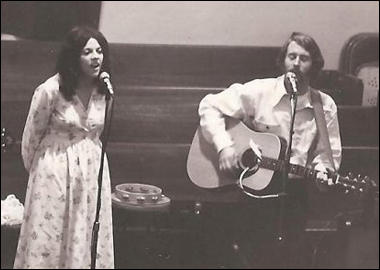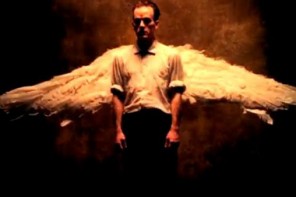A number of readers have expressed a thirst for lengthier excerpts. In response we offer this substantially longer third installment. Read all available installments here, or better yet, never miss another feature by signing up for the RD Daily Newsletter here. You’ll receive our features and blogs every day in your inbox.
Abba, a youth outreach launched in 1971 by the Chula Vista First Baptist Church and run by the church’s teens and twentysomethings, took its name from Christ’s term of endearment for his Heavenly Father. (“Abba” is Aramaic for “Daddy”). The name was perfectly suited to the laid-back, Jesus-is-just-alright vibe, heavy on the group hugs, that prevailed at the weekend “coffeehouses,” as such services were called.
Friday nights at the House of Abba were stunningly unlike the soporific Sunday mornings at Saint Mark’s Lutheran Church, where I’d spent most of my church-going life, dozing fitfully while pretending to study the mimeographed liturgy handed out at the door.
Abba’s hang-loose cool stood in stark contrast to Saint Marks’ clip-on tie conservatism. At Saint Mark’s, we sat bolt upright, in unforgiving pews; at Abba, we sat cross-legged on a patchwork carpet hand-stitched by the youth in the church’s “art ministry” to give it a crash-pad ambiance. They’d also painted the sanctuary walls with cartoony, faux-naif pop-art murals (“imagine a hippy Sistine Chapel,” the pastor’s son, Tim Pagaard, recalls).
Abba’s radicalism went far deeper than interior decoration, scrapping the liturgy and smudging the historically sharp line between clergy and congregation. To be sure, Abba services had leaders, but they were laypeople and, more to the point, young people—a breezy flouting of elder power, from a Lutheran’s-eye view. Not a reversed collar in sight, but plenty of longhairs in Pendleton shirts (worn, as SoCal style dictated, over a long john top, flannel sleeves rolled up to flaunt the underwear—an inscrutable convergence of beach-bum cool and the Little House on the Prairie couture favored by the back-to-the-garden wing of the Woodstock Nation, Richard Brautigan Division.)
Abba leaders wore their authority lightly, deciding on the fly whether we should sing, ponder a passage of scripture, or simply praise the Lord, lifting our voices in a weirdly beautiful welter of whispered prayers, wordless song, murmured praise—“thank you, Jesus”; “bless you, lord”—and, inevitably, the ecstatic babble of people speaking in tongues.
The Chula Vista First Baptist Church was a flashpoint in the so-called Charismatic Renewal, an outbreak of neo-Pentecostalism that erupted, incongruously, in American Catholicism in 1967 and spread like holy fire through the mainline Protestant denominations.
The FBC’s charismatic orientation encouraged public displays of beatified passion and, more generally, a middle-class, white (read: toned-down) version of the exuberant call-and-response dynamic that has animated black Pentecostal churches and Southern white revival meetings for generations.
On October 25, 1974, as on most Friday nights, Abba’s house band Hebron churned out folk-rock worship music, original tunes that gene-spliced David Crosby and King Crimson—a progressive take on what would come to be known as Christian Contemporary Music (CCM). Someone spoke in tongues; someone else prayed for the gift of interpretation. A girl rocked as she sang, eyes closed, cheeks silvered by tears.
I knew how she felt. Sometimes, as I tried to wrap my mind around God’s fathomless love for me—me, an insignificant speck among earth’s billions, yet He numbered the very hairs on my head—a wrenching feeling welled up inside: God’s love engulfing me, then overspilling my soul, a flood of love for all humankind.
This was agape, the Greek word the early Christians used to refer to the unconditional love God felt for us, his children, and which we were supposed to feel for the world. Equal parts transport of sanctified rapture and endorphin rush, it was the next best thing to sex, for an alienated teenage loner. Once, the feeling came over me as I sat reading the bible on one of the few hills in town untouched by development, an island of wild grass lapped by sprawl on every side. Another time, it overwhelmed me in my bedroom, as I prayed with eyes fixed on a picture torn from a magazine and taped to my wall, a blown-up detail of Christ’s sorrowful face from some Renaissance fresco—nightly devotions not unlike those performed by numberless teenage fans, in bedrooms across America, before pin-ups ripped from rock magazines like Creem or Circus or Hit Parader, except in my case the object of my obsession was the Son of God. I caught myself thinking how passionately I loved him. And I wondered what that meant. And I realized I didn’t care.
Soul love – the priest that tastes the word and
Told of love – and how my God on high is
All love – though reaching up my loneliness evolves
By the blindness that surrounds himLove is careless in its choosing – sweeping over cross a baby
Love descends on those defenseless
Idiot love will spark the fusion
Inspirations have I none – just to touch the flaming dove— David Bowie, “Soul Love,” Ziggy Stardust
Abba’s Jesus owed a debt to the Christ of the Jesus movement of the times, with which Abba shared not only historical space but cultural and, to a lesser degree, theological DNA.
Emerging on the West Coast in the late ‘60s, the Jesus movement—call them Jesus Freaks, Jesus People, street Christians, hippie Christians—was a grassroots (forgive the pun) revival rooted in the counterculture. Disenchanted by the Summer of Love’s sordid crack-up in Altamont, the Manson murders, and the zombie-eyed casualties of one too many trips, burned-out seekers began to See the Light—not the mind-frying blotter acid cooked up by Captain Clearlight, the San Francisco LSD kingpin, but The Light of the World.
Fundamentally white and middle-class in nature, it percolated out of the storefront missions and street outreaches of the urban counterculture—Ted and Elizabeth Wise’s Living Room coffeehouse in San Francisco’s Haight-Ashbury neighborhood, Arthur Blessitt’s His Place coffeehouse on the Sunset Strip, in Hollywood—into suburban America.
The Jesus movement entered the national consciousness in 1971, when Jesus Christ Superstar and Godspell opened Broadway and off-Broadway, respectively, and a pink-skinned, purple-haired Jesus in the Sky with Diamonds stared soulfully from American newsstands—the Peter Max-style illustration for Time magazine’s cover story on “The Jesus Revolution.” Time dutifully informed Middle America that:
Jesus is alive and well and living in the radical spiritual fervor of a growing number of young Americans who have proclaimed an extraordinary religious revolution in his name. […] Christian coffeehouses have opened in many cities, signaling their faith even in their names: The Way Word in Greenwich Village, the Catacombs in Seattle, I Am in Spokane. […] ‘It’s like a glacier,’ says ‘Jesus-Rock’ Singer Larry Norman, 24. ‘It’s growing and there’s no stopping it.’
Explo ’72, a “Christian Woodstock” hosted by the conservative evangelical group Campus Crusade for Christ, packed an estimated 80,000 young believers into Dallas’s Cotton Bowl. (Attendance swelled to 250,000 on the day Kris Kristofferson performed.)
The Jesus Freaks’ ad-hoc theology could be summed up in two words: solus Jesus (“Jesus alone”), a “radically Jesus-centric” Christianity (to borrow a phrase from the religious historian Stephen Prothero) that privileged a soul-joltingly emotional relationship with the Son of God. The Jesus movement took the tendency, in American Christianity, to conceive of Jesus in down-to-earth, warmly human terms to new extremes.
Unsurprisingly, the Jesus Freaks imagined Christ as one of their own—a hippie, like Ted Neeley’s sad-eyed Prince of Peaceniks in the movie version of Jesus Christ Superstar, or a surfer dude like Richard Hook’s popular Head of Christ (1964), whose stoned gaze makes him look like the kind of party-on messiah who peppered his conversation with words like “gnarly” and “bogus.” The Jesus People moved the sandaled, longhaired Son of God center stage and banished his hard-assed, disciplinarian Dad—Yaweh, assistant principal of the Old Testament—to the wings. (Yet more proof of Feuerbach’s postulate that man creates God in his own image.)
To a rebellious overthinker adrift in the Sun Belt’s answer to Stepford, Abba’s Jesus was thrillingly radical.
It was only a matter of weeks after I left Saint Mark’s for Abba, with my parents’ grudging blessing, that I found myself rising, one Friday night in 1973, to answer the altar call—the exhortation, in every evangelical service, to heed Jesus’s knock at the door of your heart and come forward, with the other converts-to-be, to Accept Jesus as Your Lord and Personal Savior.
I’d met this Jesus before, in Jesus Christ Superstar (1970): a righteous messiah, opening a can of whupass on the moneylenders, giving the one-finger salute to the hypocritical religious establishment, and suffering political martyrdom at the hands of The Man. For me, as for many boomers, Superstar was a paradigm-warping experience. When my stepdad gave the just-released original cast album to my mom, I intercepted it and played it non-stop for the rest of the day, poring over the staplebound libretto as if it were some impossibly awesome version of God’s word—which, to a 10-year-old with a spotty knowledge of scripture, it was. In a single afternoon, Deep Purple singer Ian Gillan’s arena-rock Jesus, Andrew Lloyd Webber’s hooky, guitar-driven tunes, and the Mod Squad grooviness of Tim Rice’s lyrics had re-branded Jesus, in my mind, as Pure Awesome.
Growing up, I’d come to see Christ as an Establishment Tool, ventriloquized by the same malevolent, oyster-eyed old guardians of the social order who bullied us into saying the Pledge of Allegiance, hands on hearts, before they force-marched us off to Vietnam. My Country, Right or Wrong; Support Your Local Sheriff; and God Said It, I Believe It, That Settles It were all products of the same Pavlovian conditioning, I decided; religion was just another cog in the machinery of social control.
The House of Abba Jesus, like the Jesus of Superstar and the Jesus Freaks, was poles apart, an anti-establishment troublemaker who came to turn the gerontocratic world of power and privilege upside down. He was the perfect combination of supercool role model and intimate confidante—an Invisible BFF who, unlike your parents or pastor or even your friends, totally understood you but never judged you and was always ready to kick back and listen while you poured out your tormented teenage heart.
Sure, the historical Christ was over 30, but as re-imagined by Abba, Superstar, and the hippie Christians, he was One of Us, a historical revision so right for the zeitgeist that it trickled down to my local head shop, where an unwittingly hilarious poster depicted a Jesus who looked more than one toke over the line, asserting, “You guys can wear your hair any length you want; just tell them I said so.”
As Stephen Prothero, author of American Jesus: How the Son of God Became a National Icon, puts it, the Jesus of ‘70s pop Christianity,
grew his hair long, picked up the slang of the youth culture, and started strumming a guitar (first acoustic, then electric). Like other Jesus Freaks, Jesus became a hip rebel against the square culture of the Man in the Gray Flannel Suit. He dissed his parents, quit his job, and took to the road with his closest friends.
Caiaphas, the high priest in Superstar, spoke for a generation: “One thing I’ll say for him—Jesus is cool!”
Part 4: As the coffeehouses begin to lose their outsider cool, Jesus begins to lose our hero.





